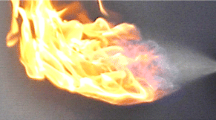Conclusions
The results of the experiments show the significant effect of the dimensions of the gas—drop system on the character of its combustion: in the range of clouds with a volume greater than 500 m3, it is possible to attain apparent flame velocities greater than 100 m/sec. Here, it was established that in large aerosol clouds of atomized hydrocarbon fuels with a similar disperse composition, the apparent velocity of the flame increases with an increase in the molecular weight of the fuel.
Comparison of the dynamics of ascent of the resulting vortex ring with the calculated data in [17] shows that the behavior of the combustion products of dispersed fuels in the free atmosphere can be classified as a case of free upward convection from an impulsive point source. The relation H(t)∼(Qit2)1/4 for this case is equivalent to the relation for the ascent of the products of a powerful explosion [14].
Similar content being viewed by others
Literature Cited
A. I. Rozlovskii, Principles of Fire Safety in the Use of Combustible Gases and Vapors [in Russian], Khimiya, Moscow (1980).
B. Lewis (ed.), Combustion Processes [Russian translation], Fizmatgiz, Moscow (1961).
N. Kh. Kopyt, A. N. Matskov, et al., “Aerosol generator,” Inventor's Cert. No. 1072919 SSSR, MKI3 V 05 V 17/00, Byull. Izobret., 6 (1984).
O. A. Isaev, Phase Transformations in Metastable Systems [in Russian], Sverdlovsk (1983).
V. P. Skripov, Metastable Liquid [in Russian], Nauka, Moscow (1972).
V. A. Grigor'ev and V. M. Zorin (eds.), Heat and Mass Transfer. Heat-Engineering Experiment (Handbook) [in Russian], Energoizdat, Moscow (1982).
B. I. Nigmatulin, K. I. Soplenkov, and V. N. Blinkov, Teplofiz. Vyz. Temp.,25, No. 4, 726 (1987).
N. F. Dubovik (ed.), Handbook of Hydrocarbon Fuels and Their Combustion Products [in Russian], Gostekhizdat, Moscow-Leningrad (1962).
A. A. Borisov, B. E. Gel'fand, et al., Inzh.-Fiz. Zh.,40, No. 1, 64 (1981).
S. N. Miroshnikov, Candidate's Dissertation, MFTI (1980).
V. I. Makeev, Yu. A. Gostintsev, et al., Fiz. Goreniya Vzryva,19, No. 5, 16 (1983).
O. M. Todes, A. D. Gol'tsiker, and Ya. G. Gorbul'skii, Dokl. Akad. Nauk SSSR,205, No. 5, 1083 (1972).
A. A. Boni, M. Chapman, et al., Prog. Astronaut. Aeronaut.,58, 373 (1978).
A. T. Onufriev, Zh. Prikl. Mekh. Tekh. Fiz., No. 2, 3 (1967).
A. A. Lugovtsov, B. A. Lugovtsov, and V. P. Tarasov, Din. Sploshnoi Sredy, No. 3 (1960).
A. I. Struchaev, V. A. Ershov, et al., Fiz. Aerodispersnykh Sist.,18 (1978).
Yu. A. Gostintsev, L. A. Sukhanov, and A. F. Solodovnik, Dokl. Akad. Nauk SSSR,252, No. 2, 311 (1980).
Additional information
Odessa. Translated from Fizika Goreniya i Vzryva, Vol. 25, No. 3, pp. 21–28, May–June, 1989.
Rights and permissions
About this article
Cite this article
Kopyt, N.K., Struchaev, A.I., Krasnoshchekov, Y.I. et al. Combustion of large volumes of dispersed fuels and the evolution of their products in the free atmosphere. Combust Explos Shock Waves 25, 279–285 (1989). https://doi.org/10.1007/BF00788797
Received:
Issue Date:
DOI: https://doi.org/10.1007/BF00788797



